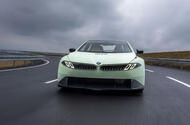The BMW Vision Driving Experience is not your typical test vehicle; it’s a glimpse into the future of electric performance and vehicle dynamics. This radical quad-motor machine is a pivotal part of BMW’s development for its next-generation electric vehicles, particularly the much-anticipated Neue Klasse models, which include the upcoming M3 EV. But what exactly makes this test mule so special, and how does it contribute to the evolution of electric driving?
What Makes the Vision Driving Experience Stand Out?
At its core, the Vision Driving Experience (or VDE for short) is a high-performance test vehicle equipped with four powerful motors—one for each wheel. While it shares some design elements with the future M3, BMW emphasizes that the VDE serves a broader purpose as a mobile laboratory. The company has chosen to keep specific power output figures under wraps, focusing instead on the vehicle’s role in developing advanced technologies.
One of the most striking features of the VDE is its innovative downforce system, which employs five fans to literally suck the car to the ground. This design is reminiscent of the McMurtry Spéirling, showcasing BMW’s commitment to pushing the boundaries of automotive engineering. The fans are not just for show; they generate significant downforce without adding drag, allowing the vehicle to maintain stability and grip during high-speed maneuvers.
The Heart of Joy: A Leap in Vehicle Dynamics
At the heart of this ambitious project lies the “Heart of Joy,” a sophisticated black box computer system that integrates the drivetrain and driving dynamics systems. This groundbreaking technology is set to revolutionize how future BMW electric vehicles operate, enhancing both performance and efficiency.
Frank Weber, BMW’s development chief, describes the Heart of Joy as a system that elevates driving pleasure to unprecedented levels. It will first debut in the next-generation iX3, followed closely by the new 3 Series saloon. The goal is to create a seamless driving experience where the vehicle responds intuitively to the driver’s inputs, whether accelerating, braking, or cornering.
A Ride in the Future: What It Feels Like
During a recent ride in the VDE, development driver Jens Klingmann demonstrated the vehicle’s capabilities with a thrilling burst of acceleration that left me breathless. The sheer power and torque of the quad-motor setup were palpable, even if the exact figures remained a mystery. The experience was akin to being in a high-performance electric rallycross car, showcasing the potential of BMW’s future offerings.
The VDE is designed to push the limits of technology, allowing engineers to test the Heart of Joy under extreme conditions. This rigorous development process ensures that even the most basic electric models will benefit from the advancements made in this high-performance test rig.
How the Heart of Joy Enhances Performance
Traditionally, the powertrain and driving dynamics systems in vehicles operate separately, which can lead to delays in communication and performance inconsistencies. The Heart of Joy changes this by unifying these systems into a single unit, allowing for real-time data processing and response. This integration enables the vehicle to react up to ten times faster than previous models, significantly improving handling and stability.
For instance, if the vehicle detects instability during a corner, it can quickly adjust power distribution among the motors to maintain balance. This level of responsiveness is crucial for enhancing both safety and driving enjoyment.
The Role of Impeller Fans in Performance
The five impeller fans on the VDE are a standout feature, generating around 1000 kg of downforce without creating drag. While they serve as an impressive demonstration of engineering prowess, BMW has confirmed that such technology is unlikely to make it into production vehicles due to cost constraints. Instead, these fans are a tool for development, helping engineers refine software and performance metrics in a controlled environment.
Looking Ahead: The Future of BMW’s Electric Vehicles
As BMW gears up to release its Neue Klasse models, the insights gained from the Vision Driving Experience will play a crucial role in shaping the next generation of electric vehicles. The advancements in the Heart of Joy system promise to enhance not just performance but also efficiency, with the potential for up to 25% improved energy use through better regenerative braking.
The VDE represents a bold step into the future, combining cutting-edge technology with the driving dynamics that BMW is known for. As we look forward to the arrival of the M3 EV and other Neue Klasse models, it’s clear that the Vision Driving Experience is more than just a test vehicle; it’s a harbinger of the exciting innovations that lie ahead in the world of electric driving.

